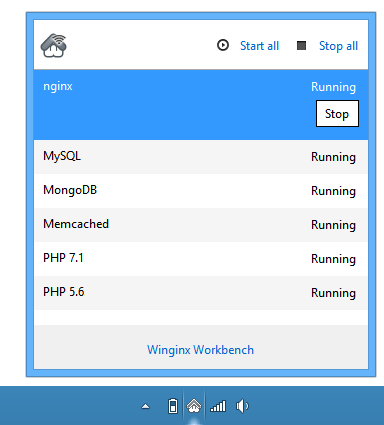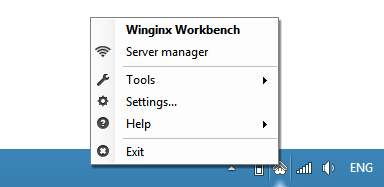Docs
Server manager
Winginx is quietly running in the system tray. Left click on its icon shows a status window of the server manager, where you can start and stop all at once or only the individual components of the server.

Right click calls a context menu with some fast commands. The context menu in the new version of Winginx has been significantly revised and simplified.

Create a new website
To create a new website with Winginx you need to add a new project.
Creating a project is based on a template you choose, from a blank website to a [CMS] (../cms). By now the templates may be accessible from the network, and also be local (right on your computer).
You can customize the web project: choose a root path for the website, server responses encoding and PHP version.
How to add a website manually?
To add a new website to the server you have to create a folder with the domain name of your local website in winginx\home, then create a subfolder public_html inside it. For example: winginx\home\site.local\public_html for a website named site.local.
The server nginx is already configured to work with multiple sites, therefore you don't need to restart your server.
However, you should remember that the domain site.local does not exist in the world. So, you shall tell your computer about this domain. This is some kind of deception of the DNS, but only locally. To do this, please use the utility HostsEditor.
Why using the dotlocal (.local) zone?
Local domains in the fictional zone .local are convenient that this zone does not overlap with other working domain zones (.com, .net, .biz, .us, etc.), so other real websites from the Internet are always available on your computer.
In addition, you can tell local website from real working website just by its name.
Sure you can think of any other fictional domain zone (for example , .dev or .localhost), if you don't like .local for some reasons.
In general, no one can stop you to create a local website with the name, say, site.com, but this is purely up to you, just don't get confused!
Any way, we can use top-level domains such as the address http://localhost/. These domains consist of a single word, and no point. For example: mysite, localsite, mysuperproject, etc.